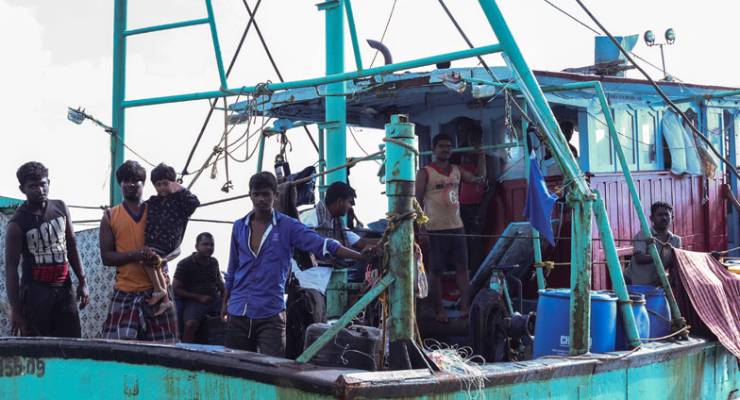
Asylum seekers bound for Australia are detained off the coast of Indonesia
When Prime Minister Malcolm Turnbull said at the UN last week that he would lift Australia’s refugee intake to 18,750, he no doubt thought he was making a generous gesture, or at least one that would be seen as such by his noisy Australian critics.
What he did, however, was spark a continued debate about how this new figure only returned the refugee intake to an earlier level and, again, what Australia’s intake should actually be. Not least, Turnbull’s claim that the new figure places Australia third among OECD countries has come under critical scrutiny.
After the depths of the Tony Abbott-led 13,000 refugee intake, a near-50% hike does look positive. But relativising refugee intake numbers was never going to wash with the many who believe Australia’s refugee policy remains profoundly off the rails.
[Turnbull is not your refugee hero — he’s making Abbott’s cuts permanent]
Both Labor and the Greens scoffed at Turnbull’s announcement. Oxfam Australia said by its own estimate, Australia should be taking 42,000 refugees a year, based on the intake during the Indochinese refugee influx of the late 1970s and early ’80s.
The government’s new figure of under 19,000 remains well below Labor’s proposed 27,000 and a shadow of the Greens’ 50,000, announced just before the last federal elections.
The government’s figure is derived from a previous refugee intake level, while Labor simply — and relatively arbitrarily — in 2015 doubled the existing refugee intake quota. The Greens’ round figure of 50,000 echoed a later Labor discussion paper, which proposed the same number.
[‘Stop the boats’ and ‘let them come’ are both pointless protests]
Having been leaked by Labor’s disaffected pro-asylum seeker lobby, the Greens appeared to head off a possible pre-election move by Labor to secure what the Greens regard as fertile electoral ground.
The Greens have not made public how they arrived at the figure of 50,000, but the Labor discussion paper was more clear. In short, the paper divided the refugee intake of all OECD countries, and factored in relative population size and per capita GDP and the growth of the global refugee numbers since 2014. The figure came out at a refugee intake of about 50,000 a year, give or take a thousand or so.
The paper was intended to demonstrate that, taking the politics out of Australia’s refugee intake, to meet the OECD average refugee intake, Australia’s refugee intake is woefully inadequate.
But Australia’s refugee policy is, if nothing else, deeply political. Basing refugee intake on precedent, arbitrarily doubling an existing number, extrapolating from an earlier intake, or borrowing from another party’s discussion paper all involve political judgment. Perhaps the only thing that is certain is that lifting refugee intake to 18,750 in two years’ time will still leave Australia a very long way short of the OECD’s third-highest refugee intake.
* Damien Kingsbury is a professor of international politics at Deakin University








I don’t know….. Have you asked one of the three faces of Malcolm?
In the absence of an effective industry policy it is politically much safer to restrict refugee intakes.
At the same time 457 visas allow large numbers of would-be migrants whose dubious status allows businesses to employ them at below award rates. If we replaced those with refugees with official status they would need to be paid award rates. That would be a clear loss for many small businesses.
Another one, ”taking” refugees is beside the point. We use a minority of refugees as pawns in our sick game so we can pretend that not helping refugees here is our obligation.
In two years time, there may not be enough refugees left to come to Australia after we and our mates have finished bombing them.
If there were fewer 457 and student visa holders getting permanent residency, there would be more room for refugees.
Agreed Ww…but I would also drastically reduce the immigration numbers. We need to look at our intake of people from ALL sources…maybe change the mix so there are lower numbers overall, but room for more refugees.
I don’t mind the 30-50,000 suggested for refugees, but not on top of the huge number coming in from all the other categories. This is just a recipe for disaster on a social cohesion/unemployment basis.
If we don’t address this growing problem, get ready for greater representation in the federal parliament of the RWNJs and their hate-speech.